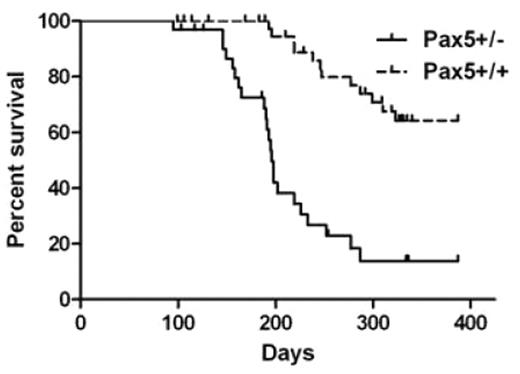Abstract
Recent genome-wide analyses of acute lymphoblastic leukemia (ALL) have identified genetic alterations targeting the B lymphoid transcription factor PAX5 in over 30% of B-progenitor ALL (
Nature2007;446:758
; Nature2008;453:110
). The PAX5 mutations include deletions, focal internal amplification, sequence mutations and translocations that result in PAX5 haploinsufficiency or generate PAX5 mutants with impaired DNA-binding or transactivating activitiy. In almost all B-ALL cases, the mutations are predicted to result in attenuation, but not complete abrogation of PAX5 activity, suggesting that PAX5 is a haploinsufficient tumor suppressor in B-ALL. To test this hypothesis, we have performed mutagenesis screens of mice heterozygous for a Pax5 null allele (Pax5+/−; Cell1994;79:901
). In a chemical mutagenesis screen, thymectomized C57BL6/Sv129 Pax5+/− (N=25) and wild type (Pax5+/+; N=20) mice received a single 100mg/kg dose of the alkylating agent N-ethyl-S-nitrosourea (ENU) at 4–5 weeks of age. Pax5+/− animals exhibited a markedly increased frequency of leukemia in comparison to wild type animals. After one year, 24 of 25 Pax5+/−animals developed leukemia (median latency 246 days), compared to 3 of 20 Pax5+/+ animals (P<0.0001, Fig. 1). Furthermore, 20 of 22 evaluable Pax5+/− tumors were of B-progenitor cell lineage, in contrast to the Pax5+/+ tumors which were either myeloid (N=2) or T-lymphoid (N=1). Moreover, the Pax5+/−tumors exhibited a range of maturation from pro-B (B220+Cd19-) to pre-B (B220+Cd19+), suggesting the acquisition of additional lesions targeting the B-cell developmental pathway in the less mature tumors. In a complementary retroviral mutagenesis study, thymectomized Pax5+/−(N=32) and Pax5+/+ (N=47) mice received a single dose of Moloney murine leukemia virus at 1–2 days after birth. Pax5+/− mice displayed a higher penetrance and reduced latency of leukemia than Pax5+/+ mice (97% of Pax5+/− mice developed leukemia with median latency of 192 days, v. 66% of Pax5+/+ mice, latency 299 days, P<0.0001). Again, a significantly higher proportion of Pax5+/− tumors (23 of 29 evaluable) were B-progenitor cell lineage than the Pax5+/+ tumors (12 of 26; P=0.01; Fig. 2), and the B-lineage tumors exhibited a spectrum of maturation from pro- to pre-B cell. Cloning and capillary sequencing of retroviral integration sites identified recurring insertions targeting the DNA polymerase gene Poln, the tumor suppressor Wwox, the tyrosine phosphatase Ptprc, the cyclin gene Ccnd3, and orthologs of genes targeted by DNA copy number alterations in human B-ALL including Tbl1xr1. Together, these data indicate that a decrease in the normal transcriptional level of Pax5 directly contributes to the development of B-progenitor ALL, consistent with Pax5 functioning as a haploinsufficient tumor suppressor. Next-generation sequencing to comprehensively identify all genes targeted by retroviral insertions, coupled with genome-wide copy number analysis, are in progress and should provide invaluable information on the range of mutations that cooperate with Pax5 haploinsufficincy to induce ALL.Fig. 1
ENU mutagenesis
Fig. 2
B-cell tumors in MoMuLV infected mice
Disclosures: No relevant conflicts of interest to declare.
Author notes
Corresponding author
2008, The American Society of Hematology
2008



